A Methodological Approach to Address Economic Vulnerability to Wildfires in Europe
Abstract
1. Introduction
2. The Vulnerability Approach
3. Materials and Methods
3.1. Area of Investigation
3.2. Provisioning Ecosystem Services
3.3. Economic Value of Properties
3.4. Regulating Ecosystem Services
3.5. Simulation of Fire
3.6. Analysis of Net-Value Change
| Ecosystem Services | Foreseen Fire Impact (FIP) Under Different Flame Length | |||||
|---|---|---|---|---|---|---|
| I 2 m | II 2–3 m | III 3–6 m | IV 6–9 m | V 9–12 m | VI >12 m | |
| Timber 1 | 0.08 | 0.17 | 0.39 | 0.58 | 0.83 | 0.90 |
| Olive_groves | 0.08 | 0.17 | 0.39 | 0.58 | 0.83 | 0.90 |
| Fruit_groves | 0.08 | 0.17 | 0.39 | 0.58 | 0.83 | 0.90 |
| Vineyard | 0.08 | 0.17 | 0.39 | 0.58 | 0.83 | 0.90 |
| Cattle and sheep 2 | 0.45 | 0.65 | 0.85 | 1.00 | 1.00 | 1.00 |
| Crop_pollination | 016 | 0.40 | 0.60 | 0.85 | 0.98 | 1.00 |
| Carbon sequestration 3 | 0.16 | 0.40 | 0.60 | 0.85 | 0.98 | 1.00 |
| Soil retention 4 | 0.15 | 0.25 | 0.45 | 0.65 | 0.95 | 1.00 |
3.7. Analysis of Fire Loss in Manufactured Capital
3.8. Assessing the Recovery Time of Natural Capital Assets to Fire
3.9. Valuation of Economic Damage
4. Results
4.1. Potential Benefits Generated by the Ecosystem Services
4.2. Assessment of Damage
5. Discussions
5.1. Contribution to the Current Knowledge on Fire Damage Estimate
5.2. Innovation in the Approach Proposed
5.3. Limits of the Approach
6. Conclusions
Author Contributions
Funding
Data Availability Statement
Acknowledgments
Conflicts of Interest
Appendix A
| Asset | Biophysical Information | Price Information | Cost or Profit Margin |
|---|---|---|---|
| Forest/ Timber | Timber growth expressed in m3/ha in each country is provided by EUROSTAT (https://www.eea.europa.eu/data-and-maps/indicators/forest-growing-stock-increment-and-fellings-3/assessment, accessed on 10 May 2025) JRC provided a forest Biomass Map showing the aboveground forest biomass density in Europe for 2010 [47]. | Stumpage price of softwood (EUR 70/m3 in June 2022) is provided by Forest Research (https://www.forestresearch.gov.uk/tools-and-resources/statistics/statistics-by-topic/timber-statistics/timber-price-indices/, accessed on 10 May 2025). | Profitability of 5% was used to calculate the net annual revenue expressed in EUR/ha per year (https://finmodelslab.com/blogs/how-much-makes/lumber-yard#:~:text=Profit%20Breakdownsandtext=For%20instance%2C%20while%20gross%20margins,boost%20margins%20in%20niche%20markets, accessed on 10 May 2025). |
| Fruit grove | EUROSTAT provided the data on fruit production and revenue for the year 2017 (https://ec.europa.eu/eurostat/statistics-explained/SEPDF/cache/53634.pdf, accessed on 10 May 2025; Statistics|Eurostat (europa.eu). | A profit margin of 20% was considered following [133]. | |
| Olive grove | EUROSTAT provided data on olive production for the period 2011 to 2021 (https://ec.europa.eu/eurostat/databrowser/view/TAG00122/default/table, accessed on 10 May 2025). | We used the average price of EUR 0.45/kg, observed in 2021 by the Italian Institute for food market (ISMEA), to convert production into revenue (https://www.ismeamercati.it/flex/cm/pages/ServeBLOB.php/L/IT/IDPagina/652, accessed on 10 May 2025) Total revenue has been divided by the area of olive plantations per country as reported by EUROSTAT (https://ec.europa.eu/eurostat/databrowser/view/orch_olives2/default/table?lang=en, accessed on 10 May 2025) | The cost of managing olive groves was estimated at EUR 500/ha (following ISMEA). An interest rate of 3% was used to calculate the capital value for olive groves. |
| Vineyard | Values of the vineyard were calculated at NUTS 2, building on EUROSTAT data (according to the classification provided in 2010). Production of wines in hectolitres is available at https://ec.europa.eu/eurostat/databrowser/view/VIT_AN7$DEFAULTVIEW/default/table, accessed on 10 May 2025. Areas of vineyard production are provided by EUROSTAT at https://ec.europa.eu/eurostat/databrowser/view/VIT_AN5$DEFAULTVIEW/default/table, accessed on 10 May 2025. Information is provided for the years 2007 and 2008. | We used the economic value of wine provided by ISMEA in 2021. We considered the price of unbottled wine as EUR 1.5 per liter. (https://www.ismeamercati.it/flex/cm/pages/ServeBLOB.php/L/IT/IDPagina/2603, accessed on 10 May 2025). This price is also confirmed by [134]. | A margin of 25% was used to calculate the net annual revenue of a vineyard. We assumed depreciation and maintenance costs of EUR 4000 per ha—(http://www.inumeridelvino.it/2014/02/il-costo-di-conduzione-della-vigna-e-potenziale-riduzione-studio-camera-agricola-di-bordeaux.html#:~:text=Il%20costo%20totale%20di%20conduzione,chimica%20ma%20molte%20pi%C3%B9%20lavorazioni, accessed on 10 May 2025). |
| Cattle | EUROSTAT reports the number of heads up to 2016 at NUTS 2 scale (https://ec.europa.eu/eurostat/databrowser/view/EF_LSK_MAIN__custom_3144197/default/table, accessed on 10 May 2025) | We used the average price of cattle in the UK, which, in 2021, was GBP 1600 (https://ahdb.org.uk/dairy-cattle-rearing-calf-prices, accessed on 10 May 2025). According to ISMEA, the market price of a life head per kg in Italy was approximately EUR 3.4 in 2022 (https://www.ismeamercati.it/flex/cm/pages/ServeBLOB.php/L/IT/IDPagina/722, accessed on 10 May 2025). Assuming an average weight of 600 kg per head (weight that can be achieved in 1 year), the value of a store cattle per head is approximately EUR 1800. | In Italy, for the year 2016, the cost of rearing livestock was approximately EUR 2.50 per kg (https://informatorezootecnico.edagricole.it/bovini-da-carne/ismea-nei-vitellone-costi-non-coprono-spese/, accessed on 10 May 2025). Correcting for inflation (prices 10% higher in 2022 than in 2016), the cost of rearing is recalculated as EUR 2.75/kg (https://tradingeconomics.com/euro-area/consumer-price-index-cpi#:~:text=Consumer%20Price%20Index%20CPI%20in%20Euro%20Area%20is%20expected%20to,macro%20models%20and%20analysts%20expectations, accessed on 10 May 2025). We assume a cost per head of EUR 1650 and a net value per head of EUR 150. |
| Sheep | EUROSTAT is used to cosuder at the NUTS 2 region the number of heads up to the year 2016 (https://ec.europa.eu/eurostat/databrowser/view/EF_LSK_MAIN__custom_3144197/default/table, accessed on 10 May 2025). | The cost of rearing a sheep was, in 2021, on average GBP 60 per ewe in the UK (https://www.cafre.ac.uk/2022/04/21/managing-rising-costs-on-sheep-farms-plan-ahead-to-remain-profitable-with-this-years-lamb-crop/, accessed on 10 May 2025). Similar values are recorded for the USA market, where the cost of rearing sheep was about USD 60 per ewe (https://familyfarmlivestock.com/raising-sheep-for-profit-lets-look-at-some-numbers//, accessed on 10 May 2025). | We assume a rearing cost of EUR 70 per head, with revenue per head in the order of EUR 3 to 4 per kg (https://www.ismeamercati.it/flex/cm/pages/ServeBLOB.php/L/IT/IDPagina/817, accessed on 10 May 2025). We assumed an average weight of 50 kg per ewe; the gross revenue per head is estimated at EUR 150 to EUR 200. We assume that, on average, the net revenue per sheep can be approximately EUR 100. |
References
- Martin, R.; Sapsis, D. Fires as Agents of Biodiversity: Pyrodiversity Promotes Biodiversity. In Proceedings of the Conference on Biodiversity of Northwest California, Santa Rosa, CA, USA, 28–30 October 1991; pp. 150–157. [Google Scholar]
- Andersen, A.N. Responses of Ant Communities to Disturbance: Five Principles for Understanding the Disturbance Dynamics of a Globally Dominant Faunal Group. J. Anim. Ecol. 2019, 88, 350–362. [Google Scholar] [CrossRef] [PubMed]
- Isbell, F.; Gonzalez, A.; Loreau, M.; Cowles, J.; Díaz, S.; Hector, A.; Mace, G.M.; Wardle, D.A.; O’Connor, M.I.; Duffy, J.E.; et al. Linking the Influence and Dependence of People on Biodiversity across Scales. Nature 2017, 546, 65–72. [Google Scholar] [CrossRef]
- Pausas, J.G.; Keeley, J.E. Wildfires as an Ecosystem Service. Front. Ecol. Environ. 2019, 17, 289–295. [Google Scholar] [CrossRef]
- Scasta, J.D. Fire and Parasites: An Under-Recognized Form of Anthropogenic Land Use Change and Mechanism of Disease Exposure. EcoHealth 2015, 12, 398–403. [Google Scholar] [CrossRef]
- European Commission. Communication from the Commission to the European Parliament, the Council, the European Economic and Social Committee and the Committee of the Regions. In Forging a Climate-Resilient Europe—The New EU Strategy on Adaptation to Climate Change; European Commission: Brussels, Belgium, 2021. [Google Scholar]
- Román, M.V.; Azqueta, D.; Rodrígues, M. Methodological Approach to Assess the Socio-Economic Vulnerability to Wildfires in Spain. For. Ecol. Manag. 2013, 294, 158–165. [Google Scholar] [CrossRef]
- Xepapadeas, P.; Douvis, K.; Kapsomenakis, I.; Xepapadeas, A.; Zerefos, C. Assessing the Link between Wildfires, Vulnerability, and Climate Change: Insights from the Regions of Greece. Sustainability 2024, 16, 4822. [Google Scholar] [CrossRef]
- Ochoa, C.; Bar-Massada, A.; Chuvieco, E. A European-Scale Analysis Reveals the Complex Roles of Anthropogenic and Climatic Factors in Driving the Initiation of Large Wildfires. Sci. Total Environ. 2024, 917, 170443. [Google Scholar] [CrossRef] [PubMed]
- Kerns, B.K.; Tortorelli, C.; Day, M.A.; Nietupski, T.; Barros, A.M.G.; Kim, J.B.; Krawchuk, M.A. Invasive Grasses: A New Perfect Storm for Forested Ecosystems? For. Ecol. Manag. 2020, 463, 117985. [Google Scholar] [CrossRef]
- Robinne, F.-N.; Hallema, D.W.; Bladon, K.D.; Flannigan, M.D.; Boisramé, G.; Bréthaut, C.M.; Doerr, S.H.; Di Baldassarre, G.; Gallagher, L.A.; Hohner, A.K.; et al. Scientists’ Warning on Extreme Wildfire Risks to Water Supply. Hydrol. Process. 2021, 35, e14086. [Google Scholar] [CrossRef]
- Kinoshita, A.M.; Chin, A.; Simon, G.L.; Briles, C.; Hogue, T.S.; O’Dowd, A.P.; Gerlak, A.K.; Albornoz, A.U. Wildfire, Water, and Society: Toward Integrative Research in the “Anthropocene”. Anthropocene 2016, 16, 16–27. [Google Scholar] [CrossRef]
- Martino, S.; Roberts, M.; Wooldridge, T.; Pol, P.O.; Mouillot, F.; Pernice, U.; Ortega, M.; Velea, R.; Laterza, R.; Moreira, B. Developing an Integrated Capitals Approach to Understanding Wildfire Vulnerability: Preliminary Considerations from a Literature Review. In Advances in Forest Fire Research 2022; Imprensa da Universidade de Coimbra: Coimbra, Portugal, 2022; pp. 849–861. ISBN 978-989-26-2298-9. [Google Scholar]
- Chuvieco, E.; Yebra, M.; Martino, S.; Thonicke, K.; Gómez-Giménez, M.; San-Miguel, J.; Oom, D.; Velea, R.; Mouillot, F.; Molina, J.R.; et al. Towards an Integrated Approach to Wildfire Risk Assessment: When, Where, What and How May the Landscapes Burn. Fire 2023, 6, 215. [Google Scholar] [CrossRef]
- Martino, S.; Roberts, M.; Wooldridge, T.; Nijnik, M.; Ovando, P.; Moreira, B.; Ortega, M.; Molina, J.R.; Velea, R.; Laterza, R.; et al. Chapter 7—Economic Impacts of Fire—A Focus on Analysis of Economic Vulnerability of Natural and Human Capitals and Proposal of an Integrated Capitals Approach to Wildfire Vulnerability. D1.4 Report on Methodological Frameworks for Vulnerability Assessment (D, S) in the FirEUrisk-Wiki. 2023. Available online: https://share.google/dOZn31nXJxyKrVWOD (accessed on 10 May 2025).
- Lamsaf, H.; Lamsaf, A.; Kerroum, M.A.; Almeida, M. Assessing Trends in Wildland-Urban Interface Fire Research through Text Mining: A Comprehensive Analysis of Published Literature. J. For. Res. 2024, 35, 71. [Google Scholar] [CrossRef]
- Molina, J.R.; y Silva, F.R. Valuation of the Economic Impact of Wildland Fires on Landscape and Recreation Resources: A Proposal to Incorporate Them on Damages Valuation; Gen. Tech. Rep. PSW-GTR-261 (English); U.S. Department of Agriculture, Forest Service, Pacific Southwest Research Station: Albany, CA, USA, 2019; pp. 228–238.
- Molina, J.R.; Rodríguez y Silva, F.; Herrera, M.Á. Economic Vulnerability of Fire-Prone Landscapes in Protected Natural Areas: Application in a Mediterranean Natural Park. Eur. J. Forest Res. 2017, 136, 609–624. [Google Scholar] [CrossRef]
- Molina, J.R.; Herrera Machuca, M.; Zamora Díaz, R.; Rodríguez y Silva, F.; González-Cabán, A. Economic Losses to Iberian Swine Production from Forest Fires. For. Policy Econ. 2011, 13, 614–621. [Google Scholar] [CrossRef]
- Arrogante-Funes, F.; Mouillot, F.; Moreira, B.; Aguado, I.; Chuvieco, E. Mapping and Assessment of Ecological Vulnerability to Wildfires in Europe. Fire Ecol. 2024, 20, 98. [Google Scholar] [CrossRef]
- Vallecillo, R.S.; La, N.A.; Kakoulaki, G.; Kamberaj, J.; Robert, N.; Dottori, F.; Feyen, L.; Rega, C.; Maes, J. Ecosystem Services Accounting—Part II Pilot Accounts for Crop and Timber Provision, Global Climate Regulation and Flood Control. Available online: https://publications.jrc.ec.europa.eu/repository/handle/JRC116334 (accessed on 2 February 2023).
- Vallecillo, S.; Kakoulaki, G.; La Notte, A.; Feyen, L.; Dottori, F.; Maes, J. Accounting for Changes in Flood Control Delivered by Ecosystems at the EU Level. Ecosyst. Serv. 2020, 44, 101142. [Google Scholar] [CrossRef]
- Chuvieco, E.; Martínez, S.; Román, M.V.; Hantson, S.; Pettinari, M.L. Integration of Ecological and Socio-Economic Factors to Assess Global Vulnerability to Wildfire. Glob. Ecol. Biogeogr. 2014, 23, 245–258. [Google Scholar] [CrossRef]
- Chuvieco, E.; Aguado, I.; Yebra, M.; Nieto, H.; Salas, J.; Martín, M.P.; Vilar, L.; Martínez, J.; Martín, S.; Ibarra, P.; et al. Development of a Framework for Fire Risk Assessment Using Remote Sensing and Geographic Information System Technologies. Ecol. Model. 2010, 221, 46–58. [Google Scholar] [CrossRef]
- Field, C.B.; Barros, V.R. Climate Change 2014: Impacts, Adaptation, and Vulnerability Working Group II Contribution to the Fifth Assessment Report of the Intergovernmental Panel on Climate Change; Cambridge University Press: New York, NY, USA, 2014; ISBN 978-1-107-64165-5. [Google Scholar]
- McGlade, J.; Bankoff, G.; Abtahams, J.; Cooper-Knock, S.; Cotecchia, F.; Desanker, P.; Erian, W.; Gencer, E.; Gibson, L.; Girgin, S. Global Assessment Report on Disaster Risk Reduction (GAR)|GAR; UN Office for Disaster Risk Reduction: Geneva, Switzerland, 2019. [Google Scholar]
- UNDRR. The Sendai Framework Terminology on Disaster Risk Reduction. “Disaster Risk”. Available online: https://www.undrr.org/terminology/disaster-risk (accessed on 10 September 2025).
- Parente, J.; Pereira, M.G. Structural Fire Risk: The Case of Portugal. Sci. Total Environ. 2016, 573, 883–893. [Google Scholar] [CrossRef]
- Molina, J.R.; Moreno, R.; Castillo, M.; Rodríguez, Y. Silva, F. Economic Susceptibility of Fire-Prone Landscapes in Natural Protected Areas of the Southern Andean Range. Sci. Total Environ. 2018, 619–620, 1557–1565. [Google Scholar] [CrossRef]
- Rodriguez y Silva, F. VISUAL-SEVEIF, a Tool for Integrating Fire Behavior Simulation and Economic Evaluation of the Impact of Wildfires. In Proceedings of the Fourth International Symposium on Fire Economics, Planning, and Policy: Climate Change and Wildfires, Mexico City, Mexico, 5–11 November 2013; GENERAL TECHNICAL REPORT PSW-GTR-245; Department of Agriculture, Forest Service, Pacific Southwest Research Station: Albany, CA, USA, 2013. [Google Scholar]
- Rodriguez y Silva, F.; González-Cabán, A. “SINAMI”: A Tool for the Economic Evaluation of Forest Fire Management Programs in Mediterranean Ecosystems. Int. J. Wildland Fire 2010, 19, 927–936. [Google Scholar] [CrossRef]
- Fuchs, R.; Brown, C.; Rounsevell, M. Europe’s Green Deal Offshores Environmental Damage to Other Nations. Nature 2020, 586, 671–673. [Google Scholar] [CrossRef] [PubMed]
- Oliveira, A.; Rajão, R.; Filho, B.; Oliveira, U.; Santos, L.; Assunção, A.; Hoff, R.; Rodrigues, H.; Carvalho Ribeiro, S.M.; Merry, F.; et al. Economic Losses to Sustainable Timber Production by Fire in the Brazilian Amazon. Geogr. J. 2018, 185, 55–67. [Google Scholar] [CrossRef]
- Oliveira, S.; Gonçalves, A.; Benali, A.; Sá, A.; Zêzere, J.L.; Pereira, J.M. Assessing Risk and Prioritizing Safety Interventions in Human Settlements Affected by Large Wildfires. Forests 2020, 11, 859. [Google Scholar] [CrossRef]
- Mallinis, G.; Petrila, M.; Mitsopoulos, I.; Lorenț, A.; Neagu, S.; Apostol, B.; Gancz, V.; Ionel, P.; Goldammer, J. Geospatial Patterns and Drivers of Forest Fire Occurrence in Romania. Appl. Spat. Anal. Policy 2019, 12, 773–795. [Google Scholar] [CrossRef]
- Andersen, L.M.; Sugg, M.M. Geographic Multi-Criteria Evaluation and Validation: A Case Study of Wildfire Vulnerability in Western North Carolina, USA Following the 2016 Wildfires. Int. J. Disaster Risk Reduct. 2019, 39, 101123. [Google Scholar] [CrossRef]
- Górriz-Mifsud, E.; Burns, M.; Marini Govigli, V. Civil Society Engaged in Wildfires: Mediterranean Forest Fire Volunteer Groupings. For. Policy Econ. 2019, 102, 119–129. [Google Scholar] [CrossRef]
- Bilbao, B.A.; Ferrero, B.G.; Falleiro, R.M.; Moura, L.C.; Fagundes, G.M. Traditional Fire Uses by Indigenous Peoples and Local Communities in South America. In Fire in the South American Ecosystems; Fidelis, A., Pivello, V.R., Eds.; Springer Nature: Cham, Switzerland, 2025; pp. 39–81. ISBN 978-3-031-89372-8. [Google Scholar]
- European Commission. Joint Research Centre. Science for Disaster Risk Management 2020: Acting Today, Protecting Tomorrow; Publications Office: Luxembourg, 2021. [Google Scholar]
- Kasperson, R.; Kasperson, J. Climate Change, Justice and Vulnerability|Joseph Rowntree Foundation; Stockholm Environment Institute: Tockholm, Sweden, 2001. [Google Scholar]
- United Nations System of Environmental Economic Accounting|Ecosystem Accounting. 2021. Available online: https://seea.un.org/ecosystem-accounting/ (accessed on 10 May 2025).
- Edens, B.; Maes, J.; Hein, L.; Obst, C.; Siikamaki, J.; Schenau, S.; Javorsek, M.; Chow, J.; Chan, J.Y.; Steurer, A.; et al. Establishing the SEEA Ecosystem Accounting as a Global Standard. Ecosyst. Serv. 2022, 54, 101413. [Google Scholar] [CrossRef]
- ONS UK Natural Capital Accounts Methodology Guide: 2023—Office for National Statistics. Available online: https://www.ons.gov.uk/economy/environmentalaccounts/methodologies/uknaturalcapitalaccountsmethodologyguide2023 (accessed on 25 April 2025).
- JRC. EEA CORINE Land Cover. Available online: https://land.copernicus.eu/en/products/corine-land-cover (accessed on 25 April 2025).
- Wine Search Gross Margins: Breaking Down the Price of a Bottle of Win. Available online: https://www.wine-searcher.com/m/2014/06/gross-margins-breaking-down-wine-prices?srsltid=AfmBOooahxZNN744DQwfv_PVlirTJiFgM5fgb--F9wTIu7ILy_JAAHsj (accessed on 10 May 2025).
- Wine Business Monthly Insight & Opinion: Vineyard Values: “Million Dollar Vineyards in Napa Valley?!”. Available online: https://www.winebusiness.com/wbm/article/183534#:~:text=At%20purchase%20prices%20of%20$275%2C000%20to%20even,the%20large%20institutional%20investment%20funds%20have%20re%2D (accessed on 10 May 2025).
- Avitabile, V.; Baldoni, E.; Baruth, B.; Bausano, G.; Boysen-Urban, K.; Caldeira, C.; Camia, A.; Cazzaniga, N.; Ceccherini, G.; De Laurentiis, V.; et al. Biomass Production, Supply, Uses and Flows in the European Union; JRC: Brussels, Belgium, 2023. [Google Scholar]
- Robinson, T.P.; Wint, G.R.W.; Conchedda, G.; Boeckel, T.P.V.; Ercoli, V.; Palamara, E.; Cinardi, G.; D’Aietti, L.; Hay, S.I.; Gilbert, M. Mapping the Global Distribution of Livestock. PLoS ONE 2014, 9, e96084. [Google Scholar] [CrossRef]
- Exchange Rates Euro to US Dollar Spot Exchange Rates for 2021. Available online: https://www.exchangerates.org.uk/EUR-USD-spot-exchange-rates-history-2021.html (accessed on 15 October 2024).
- Kummu, M.; Taka, M.; Guillaume, J.H.A. Gridded Global Datasets for Gross Domestic Product and Human Development Index over 1990–2015. Sci. Data 2018, 5, 180004. [Google Scholar] [CrossRef]
- Trading Economics Euro Area GDP Deflator. Available online: https://tradingeconomics.com/euro-area/gdp-deflator (accessed on 15 October 2024).
- Schug, F.; Bar-Masada, A.; Carlson, A.; Cox, H.; Hawbaker, T.J.; Helmers, D.; Hostert, P.; Kaim, D.; Kasraee, N.; Lewinska, K.E.; et al. Mapping and Quantifying the Global Wildland-Urban Interface. AGU Fall Meet. Abstr. 2022, 2022, NH12A-08. [Google Scholar]
- La Notte, A.; Vallecillo, S.; Polce, C.; Zulian, G.; Maes, J. Implementing an EU System of Accounting for Ecosystems and Their Services: Initial Proposals for the Implementation of Ecosystem Services Accounts; Publications Office: Luxembourg, 2017. [Google Scholar]
- La Notte, A.L.; Czúcz, B.; Vallecillo, S.; Polce, C.; Maes, J. Ecosystem Condition Underpins the Generation of Ecosystem Services: An Accounting Perspective. One Ecosyst. 2022, 7, e81487. [Google Scholar] [CrossRef]
- Vallecillo, R.S.; La, N.A.; Polce, C.; Zulian, G.; Alexandris, N.; Ferrini, S.; Maes, J. Ecosystem Services Accounting: Part I—Outdoor Recreation and Crop Pollination. Available online: https://publications.jrc.ec.europa.eu/repository/handle/JRC110321 (accessed on 15 October 2024).
- Lizundia-Loiola, J.; Otón, G.; Ramo, R.; Chuvieco, E. A Spatio-Temporal Active-Fire Clustering Approach for Global Burned Area Mapping at 250 m from MODIS Data. Remote Sens. Environ. 2020, 236, 111493. [Google Scholar] [CrossRef]
- Laurent, P.; Mouillot, F.; Yue, C.; Ciais, P.; Moreno, M.V.; Nogueira, J.M.P. FRY, a Global Database of Fire Patch Functional Traits Derived from Space-Borne Burned Area Products. Sci. Data 2018, 5, 180132. [Google Scholar] [CrossRef]
- Aragoneses, E.; García, M.; Salis, M.; Ribeiro, L.M.; Chuvieco, E. Classification and Mapping of European Fuels Using a Hierarchical, Multipurpose Fuel Classification System. Earth Syst. Sci. Data 2023, 15, 1287–1315. [Google Scholar] [CrossRef]
- Scott, J.H. Standard Fire Behavior Fuel Models: A Comprehensive Set for Use with Rothermel’s Surface Fire Spread Model; U.S. Department of Agriculture, Forest Service, Rocky Mountain Research Station: Fort Collins, CO, USA, 2005.
- Aragoneses, E.; García, M.; Ruiz-Benito, P.; Chuvieco, E. Mapping Forest Canopy Fuel Parameters at European Scale Using Spaceborne LiDAR and Satellite Data. Remote Sens. Environ. 2024, 303, 114005. [Google Scholar] [CrossRef]
- Aragoneses, E.; García, M.; Tang, H.; Chuvieco, E. A Multi-Sensor Approach Allows Confident Mapping of Forest Canopy Fuel Load and Canopy Bulk Density to Assess Wildfire Risk at the European Scale. Remote Sens. Environ. 2025, 318, 114578. [Google Scholar] [CrossRef]
- Castillo, M.E.; Molina, J.R.; Rodríguez y Silva, F.; García-Chevesich, P.; Garfias, R. A System to Evaluate Fire Impacts from Simulated Fire Behavior in Mediterranean Areas of Central Chile. Sci. Total Environ. 2017, 579, 1410–1418. [Google Scholar] [CrossRef] [PubMed]
- Keeley, J.E. Fire Severity and Plant Age in Postfire Resprouting of Woody Plants in Sage Scrub and Chaparral. Madroño 2006, 53, 373–379. [Google Scholar] [CrossRef]
- Rodríguez y Silva, F.; Ramón Molina, J.; González-Cabán, A.; Machuca, M.Á.H. Economic Vulnerability of Timber Resources to Forest Fires. J. Environ. Manag. 2012, 100, 16–21. [Google Scholar] [CrossRef] [PubMed]
- Castillo Soto, M.E. Integración de Variables y Criterios Territoriales Como Apoyo a la Protección Contra Incendios Forestales. Área piloto: Valparaiso-Chile Central. Ph.D. Thesis, Universidad de Córdoba, Córdoba, Spain, 2013. [Google Scholar]
- Zamora, R.; Molina-Martínez, J.R.; Herrera, M.A.; Rodríguez y Silva, F. A Model for Wildfire Prevention Planning in Game Resources. Ecol. Model. 2010, 221, 19–26. [Google Scholar] [CrossRef]
- Molina, J.R.; Zamora, R.; Rodríguez y Silva, F. The Role of Flagship Species in the Economic Valuation of Wildfire Impacts: An Application to Two Mediterranean Protected Areas. Sci. Total Environ. 2019, 675, 520–530. [Google Scholar] [CrossRef]
- Molina, J.R.; Herrera, M.A.; Rodríguez y Silva, F. Wildfire-Induced Reduction in the Carbon Storage of Mediterranean Ecosystems: An Application to Brush and Forest Fires Impacts Assessment. Environ. Impact Assess. Rev. 2019, 76, 88–97. [Google Scholar] [CrossRef]
- Gomez, J.A.; Amato, M.; Celano, G.; Koubouris, G.C. Organic Olive Orchards on Sloping Land: More than a Specialty Niche Production System? J. Environ. Manag. 2008, 89, 99–109. [Google Scholar] [CrossRef] [PubMed]
- Molina, J.R. Integración de Herramientas Para la Modelización Preventiva Y Socioeconómica Del Paisaje Forestal Frente a Los Incendios en Relación Con El Cambio Climático. Ph.D. Thesis, Universidad de Córdoba (ESP), Córdoba, Spain, 2008. Available online: http://purl.org/dc/dcmitype/Text (accessed on 10 May 2025).
- Molina, J.R.; González-Cabán, A.; Rodríguez y Silva, F. Potential Effects of Climate Change on Fire Behavior, Economic Susceptibility and Suppression Costs in Mediterranean Ecosystems: Córdoba Province, Spain. Forests 2019, 10, 679. [Google Scholar] [CrossRef]
- Molina, J.R.; Rodriguez y Silva, F.; Herrera, M.A.; Zamora, R. A Simulation Tool for Socio-Economic Planning on Forest Fire Suppression Management. In Forest Fires: Detection, Suppression, and Prevention; Nova Science Publishers: Hauppauge, NY, USA, 2009; pp. 33–88. [Google Scholar]
- Ribeiro, L.M.; Rodrigues, A.; Lucas, D.; Viegas, D.X. The Impact on Structures of the Pedrógão Grande Fire Complex in June 2017 (Portugal). Fire 2020, 3, 57. [Google Scholar] [CrossRef]
- Zandonella Callegher, C.; Grazieschi, G.; Wilczynski, E.; Oberegger, U.F.; Pezzutto, S. Assessment of Building Materials in the European Residential Building Stock: An Analysis at EU27 Level. Sustainability 2023, 15, 8840. [Google Scholar] [CrossRef]
- Catalina, M. Los Edificios en Los Incendios de Interfase Urabno-Forestal; EDICIONES DEL GENAL: Malaga, Spain, 2014; ISBN 978-84-616-6586-0. [Google Scholar]
- Samora-Arvela, A.; Aranha, J.; Correia, F.; Pinto, D.M.; Magalhães, C.; Tedim, F. Understanding Building Resistance to Wildfires: A Multi-Factor Approach. Fire 2023, 6, 32. [Google Scholar] [CrossRef]
- Gunderson, L.H. Ecological Resilience—In Theory and Application. Annu. Rev. Ecol. Evol. Syst. 2000, 31, 425–439. [Google Scholar] [CrossRef]
- Dakos, V.; Kéfi, S. Ecological Resilience: What to Measure and How. Environ. Res. Lett. 2022, 17, 043003. [Google Scholar] [CrossRef]
- Zhong, C.; Guo, M.; Zhou, F.; Li, J.; Yu, F.; Guo, F.-T.; Li, W. Forest Succession Trajectories after Fires in Valleys and on Slopes in the Greater Khingan Mountains, China. J. For. Res. 2023, 34, 623–640. [Google Scholar] [CrossRef]
- Meneses, B.M. Vegetation Recovery Patterns in Burned Areas Assessed with Landsat 8 OLI Imagery and Environmental Biophysical Data. Fire 2021, 4, 76. [Google Scholar] [CrossRef]
- Wei, Y.; Hu, H.; Sun, J.; Yuan, Q.; Sun, L.; Liu, H. Effect of Fire Intensity on Active Organic and Total Soil Carbon in a Larix Gmelinii Forest in the Daxing’anling Mountains, Northeastern China. J. For. Res. 2016, 27, 1351–1359. [Google Scholar] [CrossRef]
- Zhang, W.; Yu, Y.; Wu, X.; Pereira, P.; Borja, M.E.L. Integrating Preferences and Social Values for Ecosystem Services in Local Ecological Management: A Framework Applied in Xiaojiang Basin Yunnan Province, China. Land Use Policy 2020, 91, 104339. [Google Scholar] [CrossRef]
- Smith-Ramírez, C.; Castillo-Mandujano, J.; Becerra, P.; Sandoval, N.; Fuentes, R.; Allende, R.; Paz Acuña, M. Combining Remote Sensing and Field Data to Assess Recovery of the Chilean Mediterranean Vegetation after Fire: Effect of Time Elapsed and Burn Severity. For. Ecol. Manag. 2022, 503, 119800. [Google Scholar] [CrossRef]
- Rodrigues, M.; de la Riva, J.; Domingo, D.; Lamelas, T.; Ibarra, P.; Hoffrén, R.; García-Martín, A. An Empirical Assessment of the Potential of Post-Fire Recovery of Tree-Forest Communities in Mediterranean Environments. For. Ecol. Manag. 2024, 552, 121587. [Google Scholar] [CrossRef]
- Dakos, V.; Matthews, B.; Hendry, A.P.; Levine, J.; Loeuille, N.; Norberg, J.; Nosil, P.; Scheffer, M.; De Meester, L. Ecosystem Tipping Points in an Evolving World. Nat. Ecol. Evol. 2019, 3, 355–362. [Google Scholar] [CrossRef]
- Pérez-Cabello, F.; Montorio, R.; Alves, D.B. Remote Sensing Techniques to Assess Post-Fire Vegetation Recovery. Curr. Opin. Environ. Sci. Health 2021, 21, 100251. [Google Scholar] [CrossRef]
- Tanase, M.; de la Riva, J.; Santoro, M.; Pérez-Cabello, F.; Kasischke, E. Sensitivity of SAR Data to Post-Fire Forest Regrowth in Mediterranean and Boreal Forests. Remote Sens. Environ. 2011, 115, 2075–2085. [Google Scholar] [CrossRef]
- Bright, B.C.; Hudak, A.T.; Kennedy, R.E.; Braaten, J.D.; Khalyani, A.H. Examining Post-Fire Vegetation Recovery with Landsat Time Series Analysis in Three Western North American Forest Types. Fire Ecol. 2019, 15, 8. [Google Scholar] [CrossRef]
- Adámek, M.; Hadincová, V.; Wild, J. Long-Term Effect of Wildfires on Temperate Pinus Sylvestris Forests: Vegetation Dynamics and Ecosystem Resilience. For. Ecol. Manag. 2016, 380, 285–295. [Google Scholar] [CrossRef]
- Abraham, J.; Dowling, K.; Florentine, S. Risk of Post-Fire Metal Mobilization into Surface Water Resources: A Review. Sci. Total Environ. 2017, 599–600, 1740–1755. [Google Scholar] [CrossRef]
- Milazzo, F.; Fernández, P.; Peña, A.; Vanwalleghem, T. The Resilience of Soil Erosion Rates under Historical Land Use Change in Agroecosystems of Southern Spain. Sci. Total Environ. 2022, 822, 153672. [Google Scholar] [CrossRef]
- Ortega, M.; Lora, Á.; Yocom, L.; Zumaquero, R.; Molina, J.R. Effects of Fire Recurrence and Severity on Mediterranean Vegetation Dynamics: Implications for Structure and Composition in Southern Spain. Sci. Total Environ. 2025, 961, 178392. [Google Scholar] [CrossRef]
- Liu, X.; Pan, C. Effects of Recovery Time after Fire and Fire Severity on Stand Structure and Soil of Larch Forest in the Kanas National Nature Reserve, Northwest China. J. Arid Land 2019, 11, 811–823. [Google Scholar] [CrossRef]
- Belgodere, A.; Allaire, F.; Filippi, J.-B.; Mallet, V.; Guéniot, F. On the Marginal Cost of the Duration of a Wildfire. J. For. Econ. 2023, 38, 265–292. [Google Scholar] [CrossRef]
- UK Treasury the Green Book. 2022. Available online: https://www.gov.uk/government/publications/the-green-book-appraisal-and-evaluation-in-central-government/the-green-book-2020 (accessed on 17 October 2024).
- Amani, B.H.K.; N’Guessan, A.E.; Van der Meersch, V.; Derroire, G.; Piponiot, C.; Elogne, A.G.M.; Traoré, K.; N’Dja, J.K.; Hérault, B. Lessons from a Regional Analysis of Forest Recovery Trajectories in West Africa. Environ. Res. Lett. 2022, 17, 115005. [Google Scholar] [CrossRef]
- Costanza, R.; de Groot, R.; Sutton, P.; van der Ploeg, S.; Anderson, S.J.; Kubiszewski, I.; Farber, S.; Turner, R.K. Changes in the Global Value of Ecosystem Services. Glob. Environ. Chang. 2014, 26, 152–158. [Google Scholar] [CrossRef]
- Campos, P.; Caparrós, A.; Oviedo, J.L.; Ovando, P.; Álvarez-Farizo, B.; Díaz-Balteiro, L.; Carranza, J.; Beguería, S.; Díaz, M.; Herruzo, A.C.; et al. Bridging the Gap Between National and Ecosystem Accounting Application in Andalusian Forests, Spain. Ecol. Econ. 2019, 157, 218–236. [Google Scholar] [CrossRef]
- Huang, C.-H.; Finkral, A.; Sorensen, C.; Kolb, T. Toward Full Economic Valuation of Forest Fuels-Reduction Treatments. J. Environ. Manag. 2013, 130, 221–231. [Google Scholar] [CrossRef]
- Sil, Â.; Fernandes, P.M.; Rodrigues, A.P.; Alonso, J.M.; Honrado, J.P.; Perera, A.; Azevedo, J.C. Farmland Abandonment Decreases the Fire Regulation Capacity and the Fire Protection Ecosystem Service in Mountain Landscapes. Ecosyst. Serv. 2019, 36, 100908. [Google Scholar] [CrossRef]
- Mueller, J.M.; Soder, A.B.; Springer, A.E. Valuing Attributes of Forest Restoration in a Semi-Arid Watershed. Landsc. Urban Plan. 2019, 184, 78–87. [Google Scholar] [CrossRef]
- Varela, E.; Jacobsen, J.B.; Mavsar, R. Social Demand for Multiple Benefits Provided by Aleppo Pine Forest Management in Catalonia, Spain. Reg. Environ. Chang. 2017, 17, 539–550. [Google Scholar] [CrossRef]
- Kailidis, D.; Karanikola, P. Forest Fires 1900–2000; Giahoudis Editions: Thessaloniki, Greece, 2004. [Google Scholar]
- Brémond, P.; Grelot, F.; Agenais, A.-L. Review Article: Economic Evaluation of Flood Damage to Agriculture—Review and Analysis of Existing Methods. Nat. Hazards Earth Syst. Sci. 2013, 13, 2493–2512. [Google Scholar] [CrossRef]
- Stougiannidou, D.; Zafeiriou, E.; Raftoyannis, Y. Forest Fires in Greece and Their Economic Impacts on Agriculture. KnE Soc. Sci. 2020, 4, 54–70. [Google Scholar] [CrossRef]
- Zakowski, E.; Parker, L.E.; Johnson, D.; Aguirre, J.; Ostoja, S.M. California Wine Grape Growers Need Support to Manage Risks from Wildfire and Smoke. Calif. Agric. 2023, 77, 40–48. [Google Scholar] [CrossRef]
- Valatin, G. Carbon Valuation in Forestry and Prospects for European Harmonisation. Efi Tech. Rep. 97. 2014. Available online: https://efi.int/sites/default/files/files/publication-bank/2018/tr_97.pdf (accessed on 10 May 2025).
- Loomis, J.; Gonzalez-Caban, A.; Englin, J. Testing for Differential Effects of Forest Fires on Hiking and Mountain Biking Demand and Benefits. J. Agric. Resour. Econ. 2001, 26, 508–522. [Google Scholar]
- Hesseln, H.; Loomis, J.B.; González-Cabán, A.; Alexander, S. Wildfire Effects on Hiking and Biking Demand in New Mexico: A Travel Cost Study. J. Environ. Manag. 2003, 69, 359–368. [Google Scholar] [CrossRef]
- Hesseln, H.; Loomis, J.; González-Cabán, A. The Effects of Fire on Recreation Demand in Montana. West. J. Appl. For. 2004, 19, 47–53. [Google Scholar] [CrossRef][Green Version]
- Boxall, P.C.; Englin, J.E. Fire and Recreation Values in Fire-Prone Forests: Exploring an Intertemporal Amenity Function Using Pooled RP-SP Data. J. Agric. Resour. Econ. 2008, 33, 19–33. [Google Scholar][Green Version]
- Singh, A.K.; Kushwaha, M.; Rai, A.; Singh, N. Changes in Soil Microbial Response across Year Following a Wildfire in Tropical Dry Forest. For. Ecol. Manag. 2017, 391, 458–468. [Google Scholar] [CrossRef]
- Jensen, A.M.; Scanlon, T.M.; Riscassi, A.L. Emerging Investigator Series: The Effect of Wildfire on Streamwater Mercury and Organic Carbon in a Forested Watershed in the Southeastern United States. Environ. Sci. Process. Impacts 2017, 19, 1505–1517. [Google Scholar] [CrossRef]
- Cannon, S.H.; Gartner, J.E.; Rupert, M.G.; Michael, J.A.; Rea, A.H.; Parrett, C. Predicting the Probability and Volume of Postwildfire Debris Flows in the Intermountain Western United States. GSA Bull. 2010, 122, 127–144. [Google Scholar] [CrossRef]
- Santi, P.; Cannon, S.; DeGraff, J. 13.16 Wildfire and Landscape Change. In Treatise on Geomorphology; Shroder, J.F., Ed.; Academic Press: San Diego, CA, USA, 2013; pp. 262–287. ISBN 978-0-08-088522-3. [Google Scholar]
- Staley, D.M.; Tillery, A.C.; Kean, J.W.; McGuire, L.A.; Pauling, H.E.; Rengers, F.K.; Smith, J.B. Estimating Post-Fire Debris-Flow Hazards Prior to Wildfire Using a Statistical Analysis of Historical Distributions of Fire Severity from Remote Sensing Data. Int. J. Wildland Fire 2018, 27, 595–608. [Google Scholar] [CrossRef]
- De Graff, J.V.; Gallegos, A.J. The Challenge of Improving Identification of Rockfall Hazard after Wildfires. Environ. Eng. Geosci. 2012, 18, 389–397. [Google Scholar] [CrossRef]
- Jones, B.A.; Thacher, J.A.; Chermak, J.M.; Berrens, R.P. Wildfire Smoke Health Costs: A Methods Case Study for a Southwestern US ‘Mega-Fire’. J. Environ. Econ. Policy 2016, 5, 181–199. [Google Scholar] [CrossRef]
- Jones, B.A. Willingness to Pay Estimates for Wildfire Smoke Health Impacts in the US Using the Life Satisfaction Approach. J. Environ. Econ. Policy 2018, 7, 403–419. [Google Scholar] [CrossRef]
- Richardson, L.A.; Champ, P.A.; Loomis, J.B. The Hidden Cost of Wildfires: Economic Valuation of Health Effects of Wildfire Smoke Exposure in Southern California. J. For. Econ. 2012, 18, 14–35. [Google Scholar] [CrossRef]
- Richardson, L.; Loomis, J.B.; Champ, P.A. Valuing Morbidity from Wildfire Smoke Exposure: A Comparison of Revealed and Stated Preference Techniques. Land Econ. 2013, 89, 76–100. [Google Scholar] [CrossRef]
- Tan-Soo, J.-S.; Pattanayak, S.K. Seeking Natural Capital Projects: Forest Fires, Haze, and Early-Life Exposure in Indonesia. Proc. Natl. Acad. Sci. USA 2019, 116, 5239–5245. [Google Scholar] [CrossRef]
- Wang, D.; Guan, D.; Zhu, S.; Kinnon, M.M.; Geng, G.; Zhang, Q.; Zheng, H.; Lei, T.; Shao, S.; Gong, P.; et al. Economic Footprint of California Wildfires in 2018. Nat. Sustain. 2021, 4, 252–260. [Google Scholar] [CrossRef]
- Nielsen-Pincus, M.; Moseley, C.; Gebert, K. Job Growth and Loss across Sectors and Time in the Western US: The Impact of Large Wildfires. For. Policy Econ. 2014, 38, 199–206. [Google Scholar] [CrossRef]
- Kattge, J.; Bönisch, G.; Díaz, S.; Lavorel, S.; Prentice, I.C.; Leadley, P.; Tautenhahn, S.; Werner, G.D.A.; Aakala, T.; Abedi, M.; et al. TRY Plant Trait Database—Enhanced Coverage and Open Access. Glob. Chang. Biol. 2020, 26, 119–188. [Google Scholar] [CrossRef]
- Pearce, D.W.; Turner, R.K. Economics of Natural Resources and the Environment; Johns Hopkins University Press: Baltimore, MD, USA, 1990; ISBN 978-0-8018-3986-3. [Google Scholar]
- Pearce, D.; Groom, B.; Hepburn, C.; Koundouri, P. Valuing the Future: Recent Advances in Social Discounting. World Econ. 2003, 4, 121–141. [Google Scholar]
- Pearce, D.; Atkinson, G.; Mourato, S. Cost-Benefit Analysis and the Environment: Recent Developments; OECD: Paris, France, 2006; ISBN 978-92-64-01004-8. [Google Scholar]
- Lozhnikova, A.V.; Akkerman, E.N.; Muravyov, I.V.; Kirpotin, S.N. The ‘Tyranny of Discounting’ in Economic Efficiency Evaluation of Capital Investment Projects Susceptible to Ecological and Climatic Changes. Int. J. Environ. Stud. 2014, 71, 768–773. [Google Scholar] [CrossRef]
- Paveglio, T.B.; Abrams, J.; Ellison, A. Developing Fire Adapted Communities: The Importance of Interactions Among Elements of Local Context. Soc. Nat. Resour. 2016, 29, 1246–1261. [Google Scholar] [CrossRef]
- Paveglio, T.B.; Stasiewicz, A.M.; Edgeley, C.M. Understanding Support for Regulatory Approaches to Wildfire Management and Performance of Property Mitigations on Private Lands. Land Use Policy 2021, 100, 104893. [Google Scholar] [CrossRef]
- Domingos, T.; Kalapodis, N.; Sakkas, G.; Chandramouli, K.; Gama, I.; Proença, V.; Ribeiro, I.; Pio, M. Advancing Integrated Fire Management and Closer-to-Nature Forest Management: A Holistic Approach to Wildfire Risk Reduction and Ecosystem Resilience in Quinta Da França, Portugal. Forests 2025, 16, 1306. [Google Scholar] [CrossRef]
- Badiu, D.; Arion, F.H.; Muresan, I.C.; Lile, R.; Mitre, V. Evaluation of Economic Efficiency of Apple Orchard Investments. Sustainability 2015, 7, 10521–10533. [Google Scholar] [CrossRef]
- Dimitrova, D.; Dimitrov, V. Anuual Changes in the Prices of Table Grapes and Price Margins in the Supply Chain. Sci. Pap. Ser. Manag. Econ. Eng. Agric. Rural. Dev. 2021, 21, 219–226. [Google Scholar]
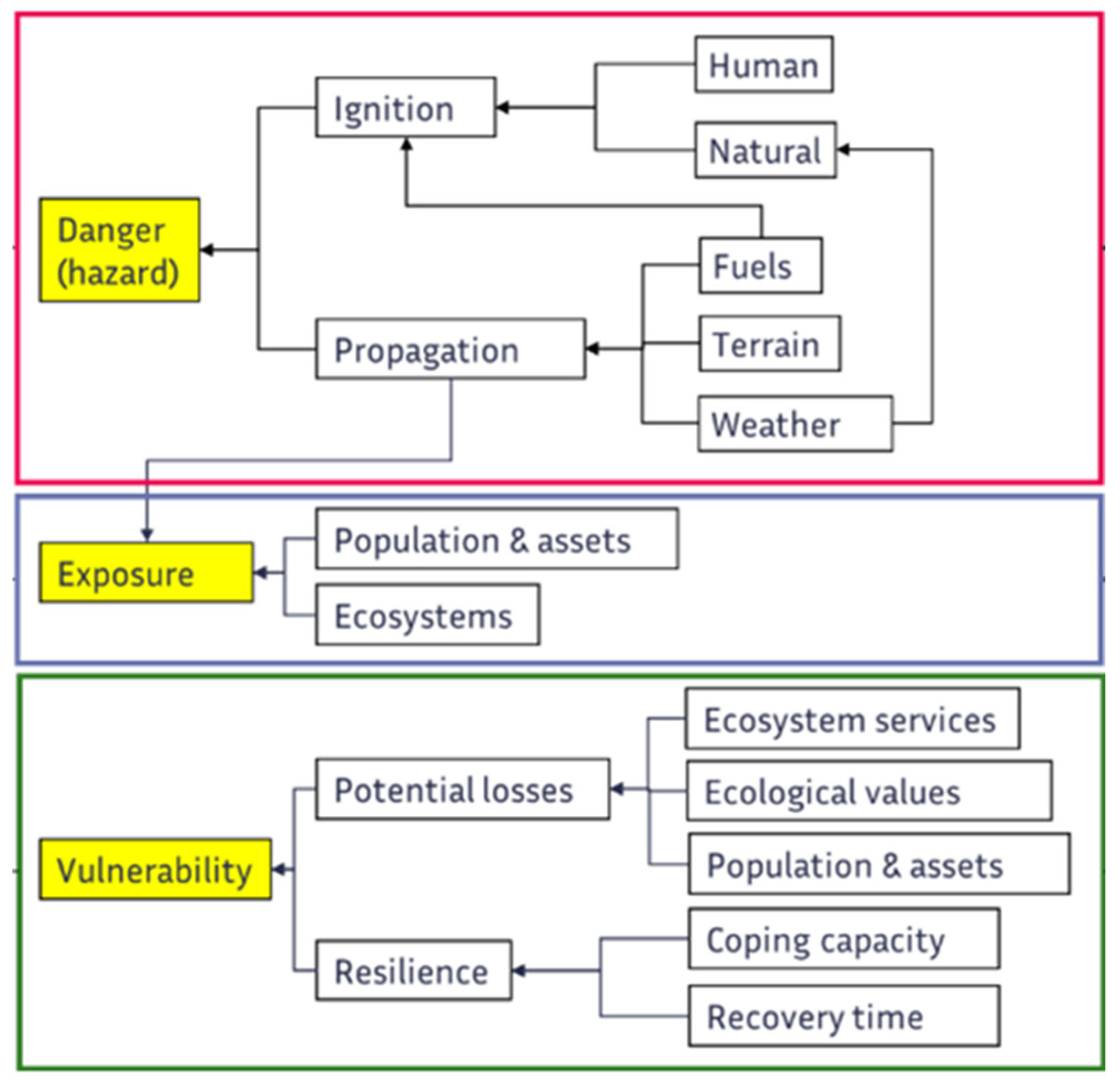

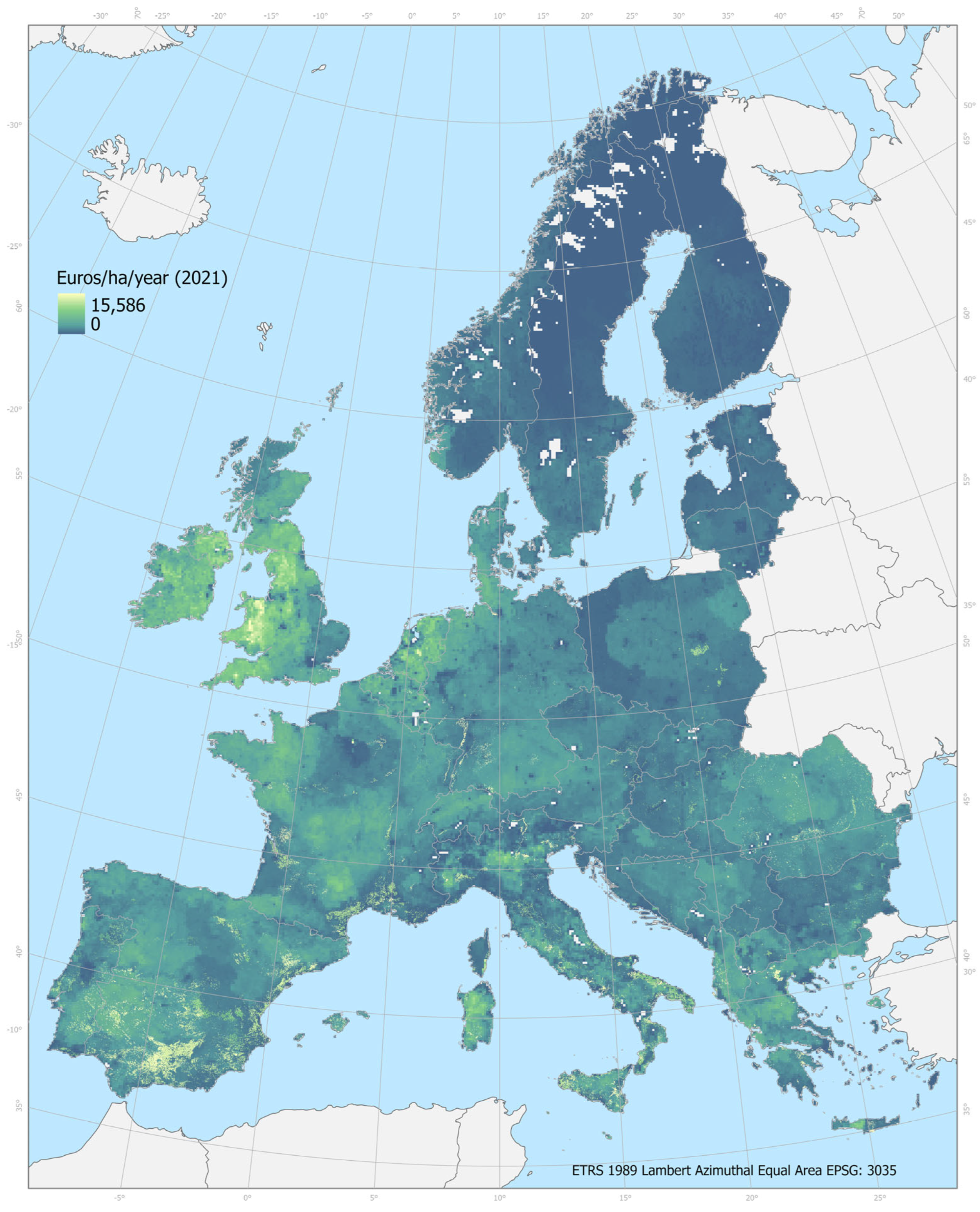
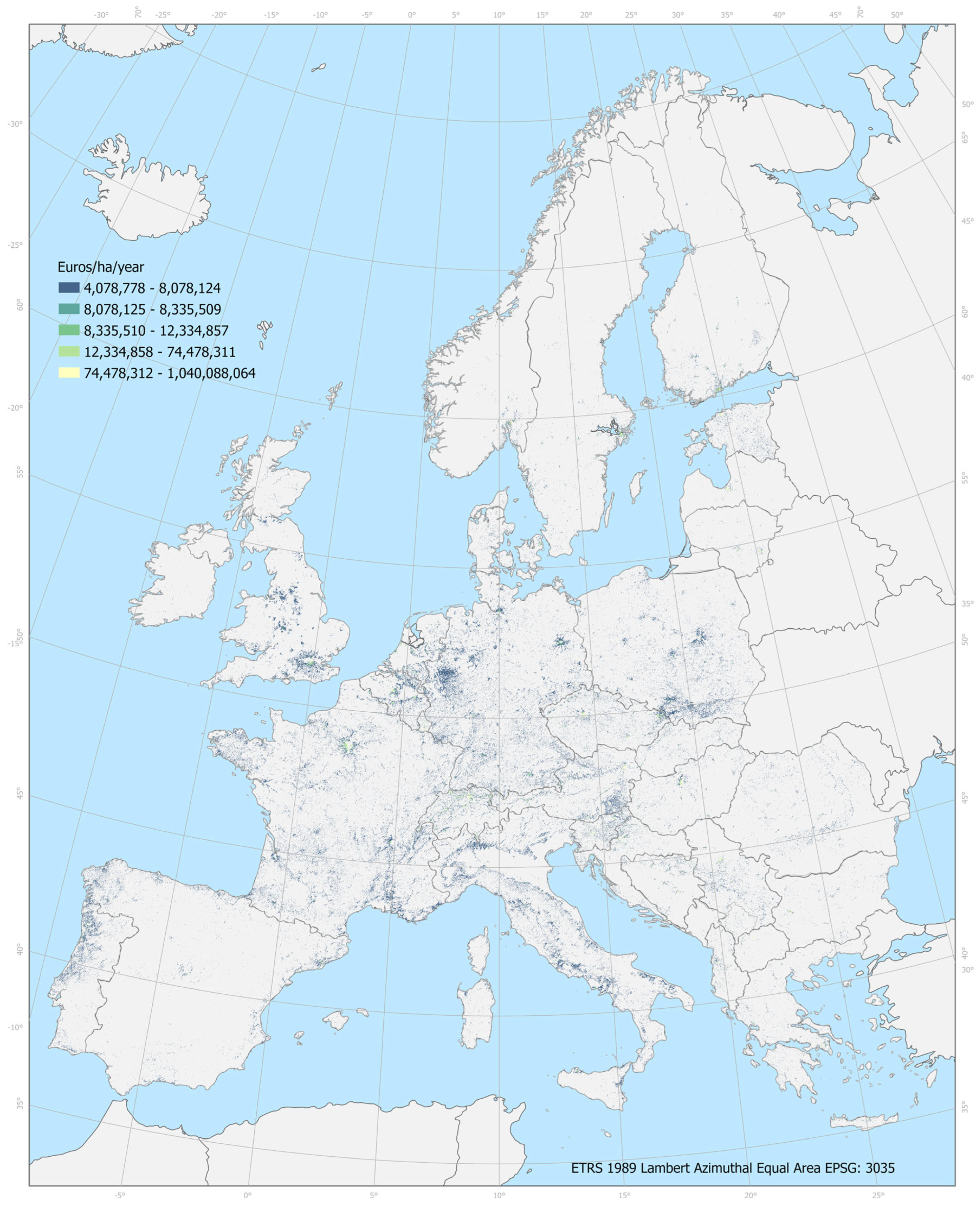
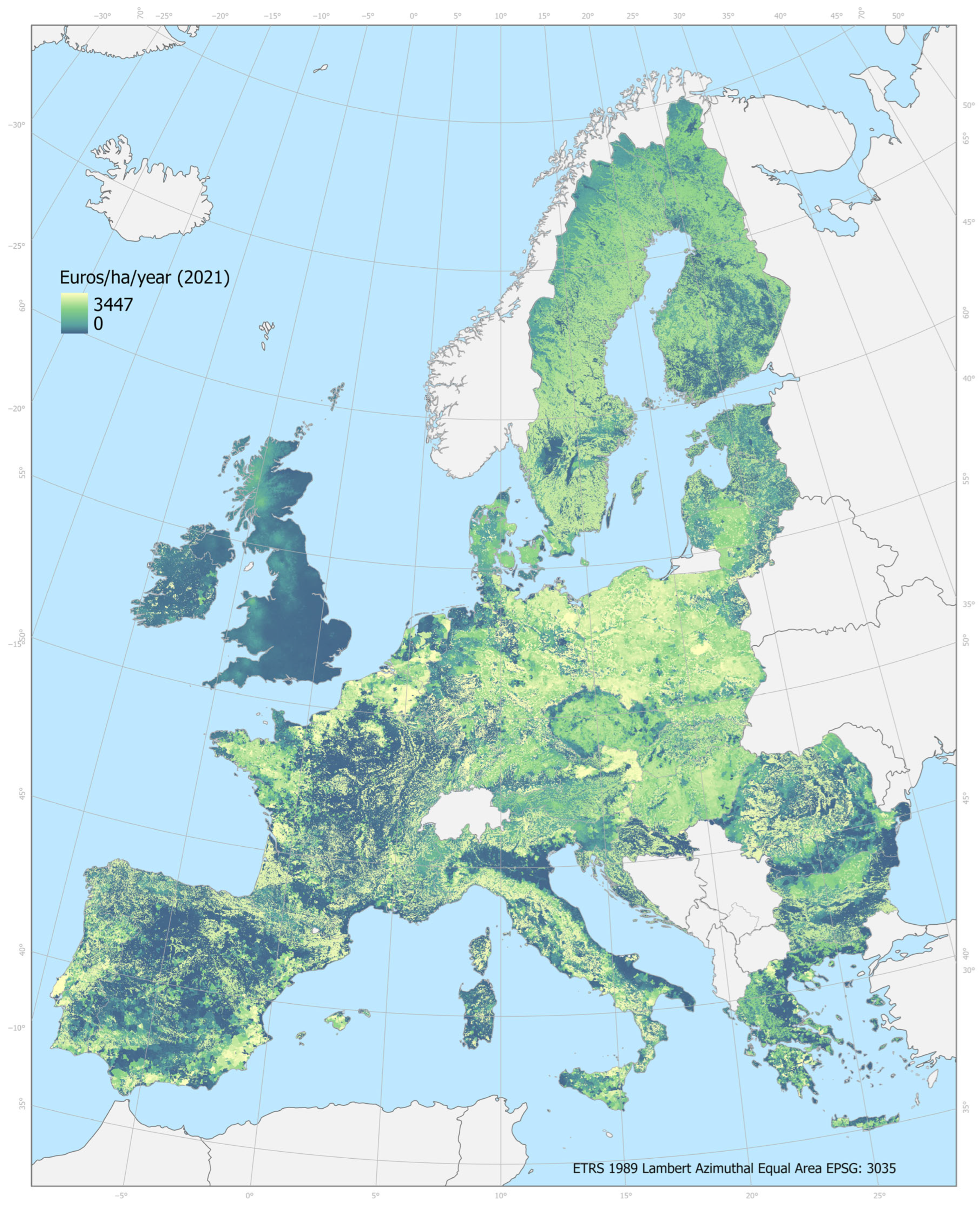


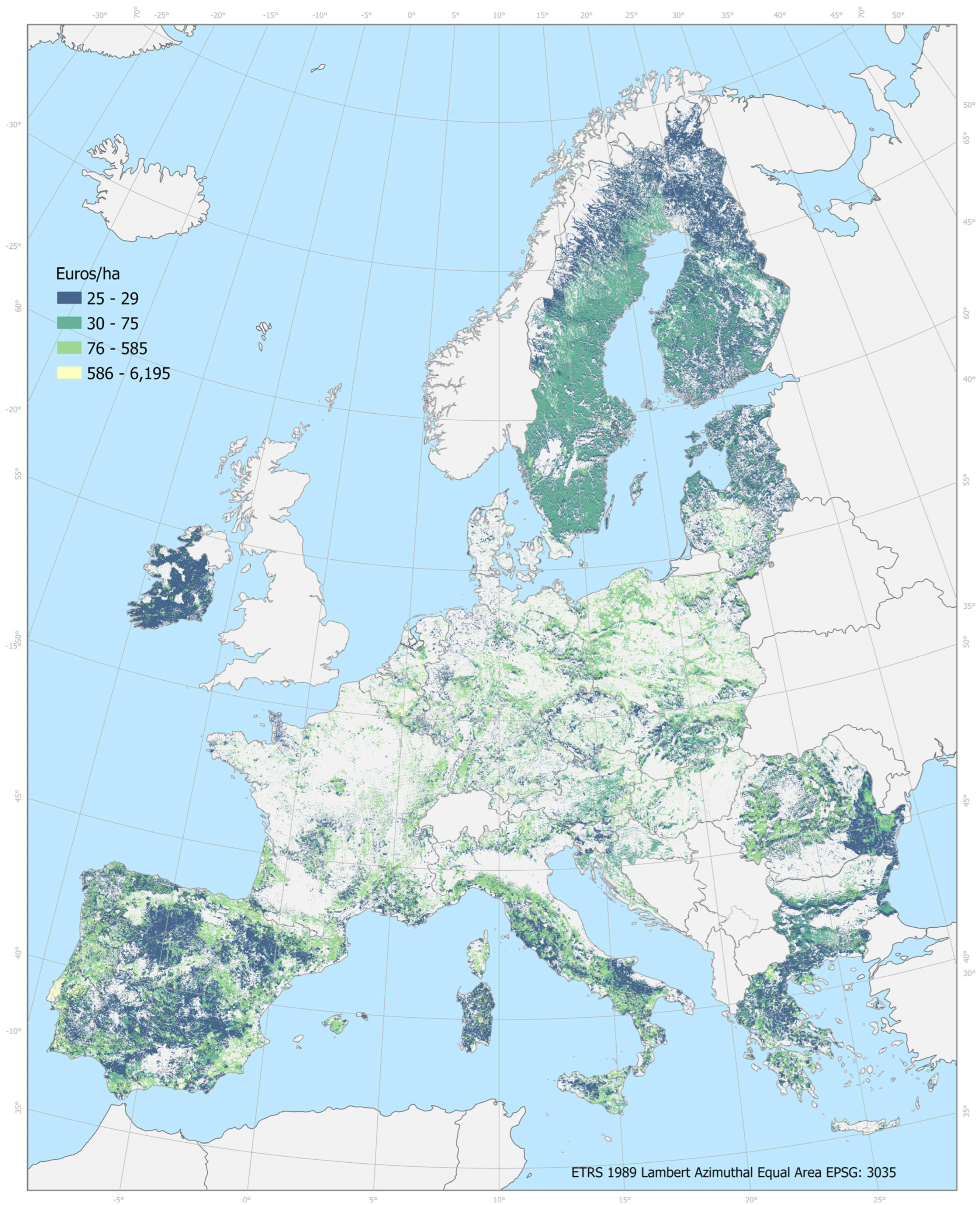
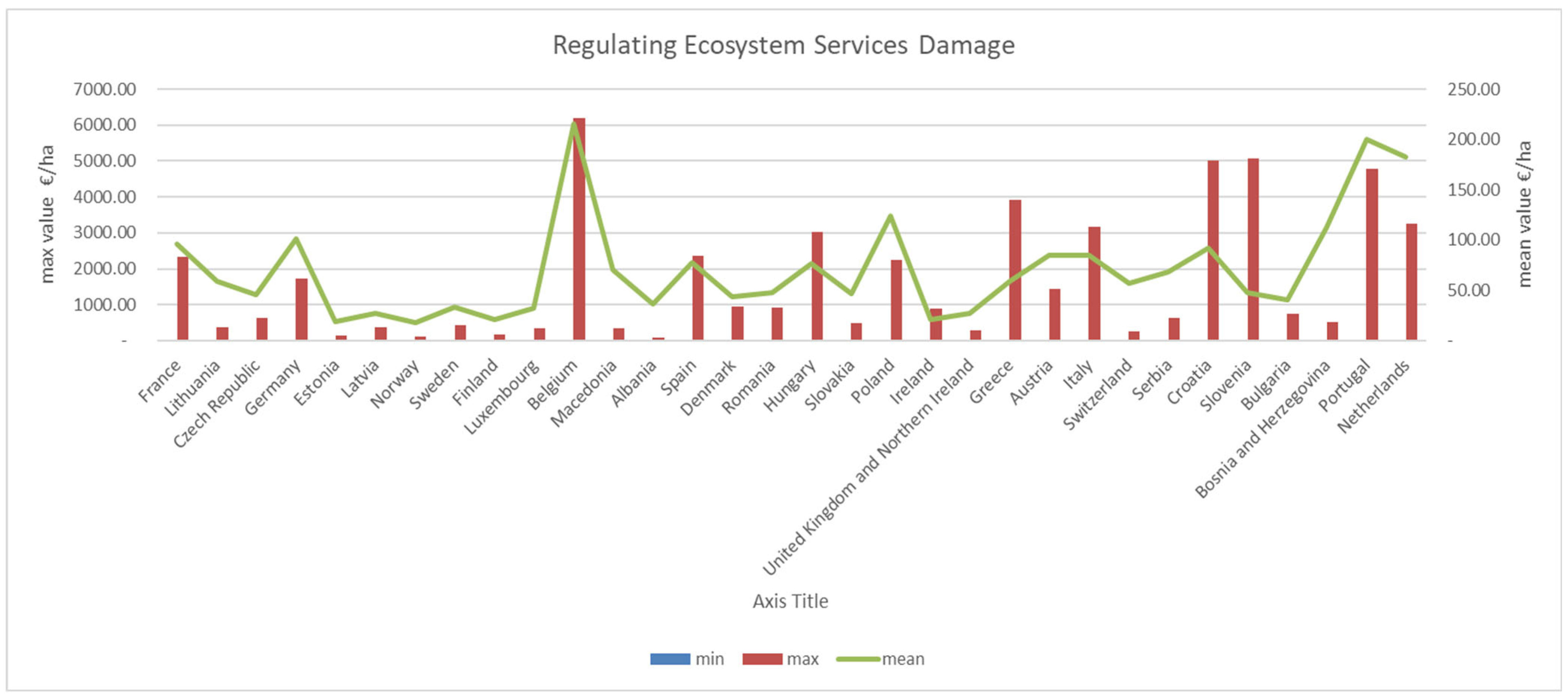
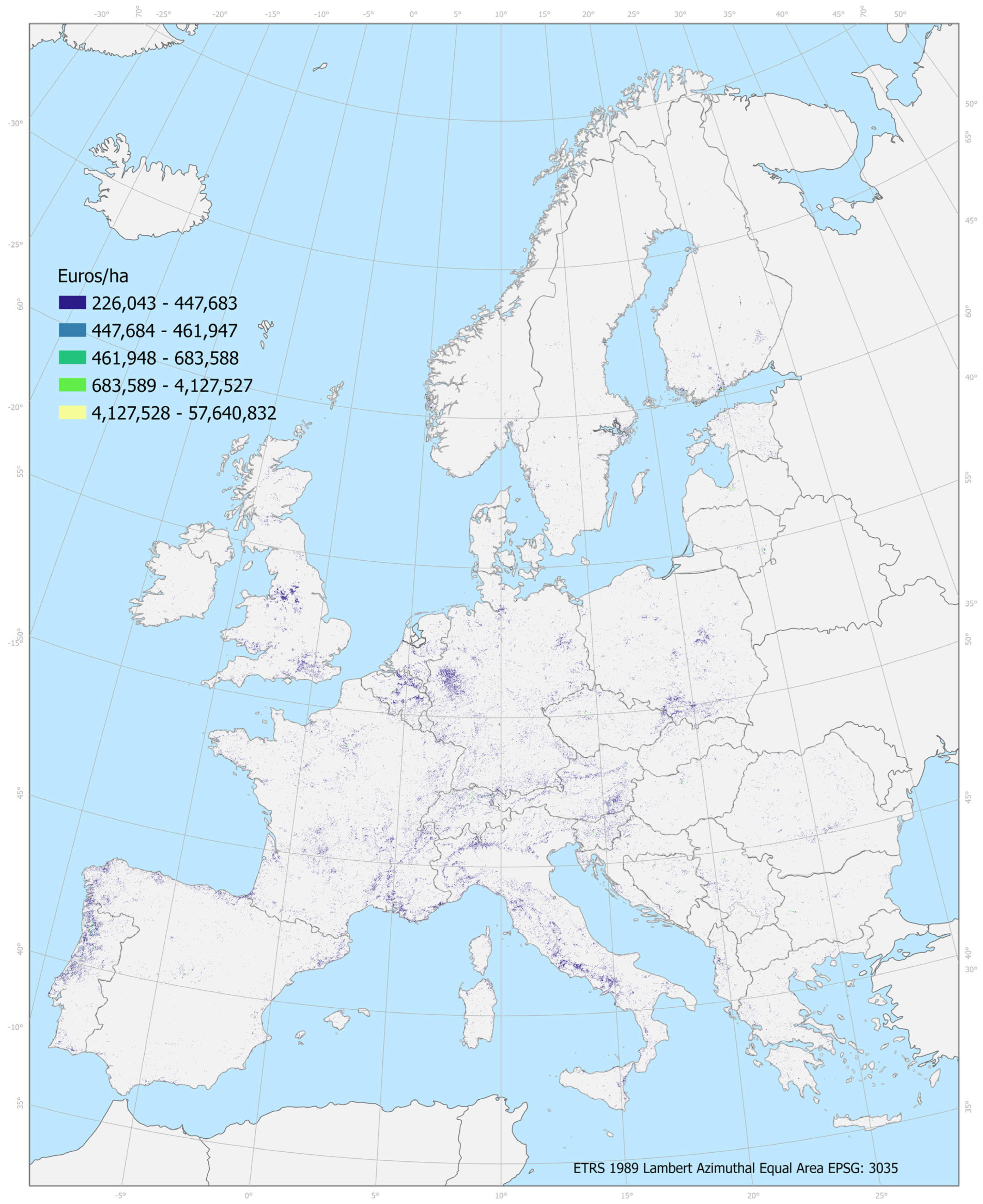
| Provisioning Ecosystem Services EUR/ha/year (2021) | Regulating Ecosystem Services EUR/ha/year (2021) | Manufactured Capital EUR/ha/year (2021) | |
|---|---|---|---|
| Fruit groves | Cattle | Crop pollination | Residential properties |
| Olive groves | Sheep | Soil retention | |
| Timber | Vineyards | Carbon sequestration | |
| Properties | FIP and Flame Length | |||||
|---|---|---|---|---|---|---|
| I | II | III | IV | V | VI | |
| Made of wood | 0.05 | 0.20 | 0.52 | 0.77 | 0.90 | 0.95 |
| Made of concrete and bricks | 0.01 | 0.05 | 0.12 | 0.20 | 0.40 | 0.60 |
| Property made of 30% wood and 70% concrete and bricks | 0.022 | 0.095 | 0.24 | 0.37 | 0.55 | 0.71 |
| Asset | Recovery Time |
|---|---|
| Fruit trees, olive groves, vineyard | 5 years |
| Timber | 50 years |
| Carbon sequestration | 50 years |
| Pollination | 6 years |
| Soil erosion | 6 years—for FIP intensity (I and II) 13 years—for FIP intensity (III and IV) 20 years—for FIP intensity (III and IV) |
| Livestock | 1 year—sheep 2 years—cattle |
| K | xo = 10 | xo = 25 | xo = 35 |
|---|---|---|---|
| 0.10 | 8.45 | 14.07 | 17.3 |
| 0.25 | 7.64 | 15.65 | 19.36 |
| 0.50 | 7.74 | 16.11 | 19.73 |
| average | 7.94 | 15.27 | 18.80 |
| damage | FIP I and II | FIP III and IV | FIP V and VI |
Disclaimer/Publisher’s Note: The statements, opinions and data contained in all publications are solely those of the individual author(s) and contributor(s) and not of MDPI and/or the editor(s). MDPI and/or the editor(s) disclaim responsibility for any injury to people or property resulting from any ideas, methods, instructions or products referred to in the content. |
© 2025 by the authors. Licensee MDPI, Basel, Switzerland. This article is an open access article distributed under the terms and conditions of the Creative Commons Attribution (CC BY) license (https://creativecommons.org/licenses/by/4.0/).
Share and Cite
Martino, S.; Ochoa, C.; Molina, J.R.; Chuvieco, E. A Methodological Approach to Address Economic Vulnerability to Wildfires in Europe. Fire 2025, 8, 379. https://doi.org/10.3390/fire8100379
Martino S, Ochoa C, Molina JR, Chuvieco E. A Methodological Approach to Address Economic Vulnerability to Wildfires in Europe. Fire. 2025; 8(10):379. https://doi.org/10.3390/fire8100379
Chicago/Turabian StyleMartino, Simone, Clara Ochoa, Juan Ramon Molina, and Emilio Chuvieco. 2025. "A Methodological Approach to Address Economic Vulnerability to Wildfires in Europe" Fire 8, no. 10: 379. https://doi.org/10.3390/fire8100379
APA StyleMartino, S., Ochoa, C., Molina, J. R., & Chuvieco, E. (2025). A Methodological Approach to Address Economic Vulnerability to Wildfires in Europe. Fire, 8(10), 379. https://doi.org/10.3390/fire8100379








